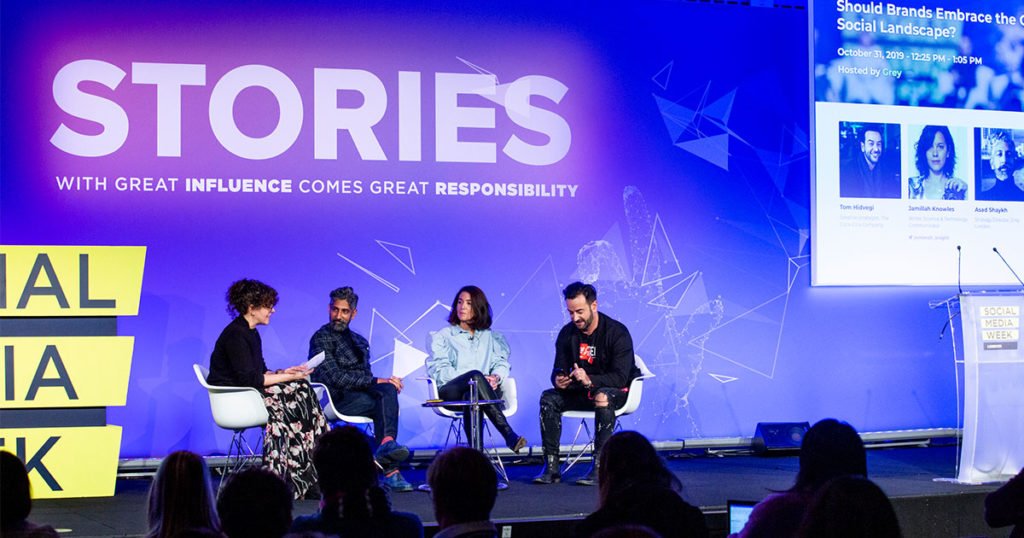As moderator Jamillah Knowles was quick to point out, the Grey-sponsored panel on social media and trust had a timely development to discuss: Twitter CEO Jack Dorsey’s ban on paid political advertising. Grey’s Strategy Director Asad Shayk likened Twitter, and any other platform where people seek to congregate, as a private party.
Brands entering these spaces, then, is akin to “bust[ing] into the private party, [shouting] ‘I’m here! I’m amazing! Love me!’” Given how most of us would treat a person who behaved in such a way, it’s no surprise that 58% of consumers in a YouGov and Grey study of 2000 UK social users don’t trust influencers, that 76% don’t think advertising on social is scrutinized like it is in other media, and a whopping 83% want political advertising regulated.
Join SMW Insider to watch this #SMWLDN session
Subscribe
So in light of those statistics that would make it challenging for marketers to do their work in these spaces, what is the right way to navigate them in a trustworthy fashion?
Less Leaning on Labels

The Coca-Cola Company’s Tom Hidvegi wants to see marketers rely less on labeling—of strategy, or of generations or target audiences. In doing so, brands are moving away from how people speak or would like to be spoken to in these spaces that were originally designed for social interaction. Even as their corporate objectives move ever farther from that initial goal, the average user still wants to be able to use it to connect with people. And to fit in these spaces in a trustworthy fashion, marketers should respect that wish. “If you’re [talking about the brand] passionately, they will join you.” His goal? Less classifying or measuring the work, more “waiting for that magical moment where someone says, ‘I love that brand.’”
Shayk agreed with Hidvegi on the measurement point, invoking Goodhart’s law: “if a measure becomes the goal, it’s stopped being a good measure.” When marketing chased first vanity metrics such as likes, favorites, and retweets, and then the nebulously labeled engagements, we got away from that feeling that Hidvegi talks about. By continuing to value that feeling, and working in earnest to cultivate it in the work, we’ll move back to the side of trust.
No More Noise. There’s No Need.

HMD Global’s Delphine Varenne put it elegantly when she acknowledged, “the brand has become selfish in the past few years, pushing. Does [the content] matter? Do people use it?” And Hidvegi picked up on her choice of language here, observing that what we make should pull people into a conversation willingly, not push them there without consent or desire. Given how quickly data is proliferating over time, and how often the veracity of that data needs to be confirmed, being a trustworthy marketer should mean being thoughtful about how what we put out—to humans who are likely just as busy and overwhelmed as we are—and behaving with that knowledge in mind.
For that, Varenne elaborated with a series of questions that can prevent marketers from manufacturing noise, and instead guide them toward crafting meaningful content:
When we start creative, we ask: why would someone be interested in us? What do people need? What are they looking for that we can address? What conversations can we meaningfully contribute to?
This approach, of knowing where our voices are needed or wanted and going there, can help rebuild some of the trust that years of aggressive but inattentive social strategy has eroded over time.
“Make Ideas Channel-Agnostic”

It was refreshing to hear the panel in agreement on the idea that proposed regulation doesn’t have to hinder the work that marketers do on platforms. In a number of ways, it will force it to be more interesting, more thoughtful, and more creative. “If creative ideas rule, monopolies can’t exist because they don’t have the rules of engagement to say what works and what doesn’t work,” Shayk shared, acknowledging that his stance may seem a bit contrary coming from the “numbers guy” on the panel. “Numbers have been imposed on us by monopolies.”
Similarly, agnosticism of channel means that we can stop declaring premature death of the channels that could ultimately amplify our messages. Hidvegi lamented the “[blank] is dead” mentality that so many seem excited to deploy, noting “nothing dies, and nothing [else] is perfect. It doesn’t have to be either/or…we all need each other!” By acknowledging that the channel is far less important than the message being shared on it, we can dispense with “hacking” tactics and go back to what many got into this work for: the opportunity to creatively give people what they want or need. And this task will need to persist even if regulation does go into place.
The good news, in Varenne’s eyes? We have the choice to let these prospective regulations guide the work. “It’s our challenge to rebuild trust [on] these platforms, by listening and delivering on what they say. It’s good and healthy to be challenged.” And with any luck, brands worldwide will take on this challenge to bring trust back to these seemingly compromised places.
Join 100,000+ fellow marketers who advance their skills and knowledge by subscribing to our weekly newsletter.
